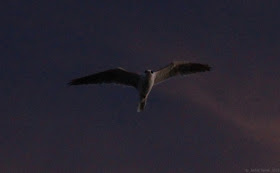The kites' arrival time to their roost has been tracking sunset (and their departures have tracked sunrise) —
which isn't surprising, but it has made me wonder. How do they decide when it's time to leave their hunting grounds? And it's been interesting to see that the weather affects their departure time from the roost. The kites "sleep in" on foggy days, and sometimes even "go back to bed" after a brief flight. Are they cold? Are they waiting for better visibility? Are they waiting for a light cue?
When seen from certain angles, the dark markings around their eyes make their eyes look so large! Does that intimidate other birds? Or does it make them look impressive to each other? Or, is it similar to eye-black and helps reduce glare?
Seeing lots of individuals allows you to appreciate variation. Many of the kites seem to be molting and replacing their tail feathers. Look for some shorter tail feathers (image above), compared to full-length tail feathers (image below). Is it typical for kites to molt in October? The Birds of North America account shows a question mark for molting in October, but mentions that it's possible the molt extends later into the year.
Below, a kite looks back at an approaching crow:
I'm still fascinated by this crow-chasing-kite behavior. The kites make evasive maneuvers and sometimes screech at the crows. (Some of the crows chase kites, others seem to fly right by.) Occasionally the crows "buzz" a perched kite, but most of the time the crows abandon the chase once the kites have perched. Sometimes it seems like the crows remember where the kite roost is and that they fly by, waiting for a chance for a chase. The crows also dive at other crows. Could the kite-chasing behavior be a form of "practice" for the crows in preparation for interactions with their own kind?





No comments:
Post a Comment